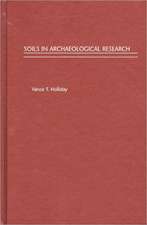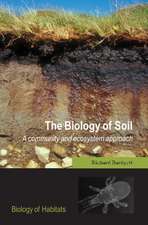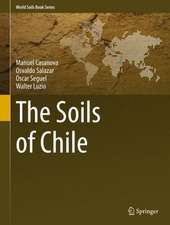Micromorphology of Soils
Autor E. A. FitzPatricken Limba Engleză Paperback – 14 oct 2011
Preț: 647.92 lei
Preț vechi: 762.26 lei
-15% Nou
Puncte Express: 972
Preț estimativ în valută:
123.100€ • 128.97$ • 102.37£
123.100€ • 128.97$ • 102.37£
Carte tipărită la comandă
Livrare economică 14-28 aprilie
Preluare comenzi: 021 569.72.76
Specificații
ISBN-13: 9789401089463
ISBN-10: 9401089469
Pagini: 452
Ilustrații: XIV, 434 p.
Dimensiuni: 155 x 235 x 27 mm
Greutate: 0.63 kg
Ediția:Softcover reprint of the original 1st ed. 1984
Editura: SPRINGER NETHERLANDS
Colecția Springer
Locul publicării:Dordrecht, Netherlands
ISBN-10: 9401089469
Pagini: 452
Ilustrații: XIV, 434 p.
Dimensiuni: 155 x 235 x 27 mm
Greutate: 0.63 kg
Ediția:Softcover reprint of the original 1st ed. 1984
Editura: SPRINGER NETHERLANDS
Colecția Springer
Locul publicării:Dordrecht, Netherlands
Public țintă
ResearchCuprins
1. Principles of thin section preparation.- 1.1 Choosing the size of the thin section.- 1.2 Collecting the sample.- 1.3 Removing water from the sample.- 1.4 Impregnating the sample.- 1.5 Lapping the impregnated sample.- 1.6 Polishing the impregnated sample.- 1.7 Grinding, lapping and polishing the slide.- 2. Preparation of polished blocks and thin sections of soils.- 2.1 Collection of samples of soft coherent non-stony material.- 2.2 Collection of samples of hard material.- 2.3 Collecting loose friable surface samples.- 2.4 Removal or replacement of water and impregnation with Crystic resin.- 2.5 Transferring the specimen to the impregnation mould.- 2.6 Removal of water.- 2.7 Impregnation.- 2.8 Sawing the impregnated block.- 2.9 Surface impregnation with Crystic resin.- 2.10 Lapping the block.- 2.11 Polishing the block.- 2.12 Cleaning the polished block.- 2.13 Mounting the polished block.- 2.14 Labelling the slide.- 2.15 Cutting off the excess specimen.- 2.16 Machine grinding the specimen.- 2.17 Final lapping stages for the specimen.- 2.18 Polishing the specimen.- 2.19 Mounting the cover glass.- 2.20 Logitech machine systems for thin section production.- 3. Examination of thin sections and polished blocks.- 3.1 Examination of thin sections and polished blocks with the stereo-microscope.- 3.2 Examination of thin sections with the petrological microscope.- 3.3 The construction and use of the petrological microscope.- 3.4 Properties of minerals determined with the petrological microscope.- 4 Properties of minerals in thin sections.- 4.1 Allophane.- 4.2 Amphiboles.- 4.3 Anatase.- 4.4 Antigorite-chrysotile.- 4.5 Apatite.- 4.6 Augite.- 4.7 Biotite.- 4.8 Calcite.- 4.9 Chalcedony.- 4.10 Chlorite.- 4.11 Clinozoisite.- 4.12 Diopside.- 4.13 Enstatite.- 4.14 Epidote.- 4.15 Feldspars.- 4.16 Ferric hydroxide.- 4.17 Garnet.- 4.18 Gibbsite.- 4.19 Goethite.- 4.20 Gypsum.- 4.21 Halite.- 4.22 Halloysite and metahalloysite.- 4.23 Hematite.- 4.24 Hornblende.- 4.25 Hypersthene.- 4.26 Ice.- 4.27 Iddingsite.- 4.28 Ilmenite.- 4.29 Jarosite.- 4.30 Kaolinite.- 4.31 Lepidocrocite.- 4.32 Magnetite.- 4.33 Manganese dioxide.- 4.34 Microcline.- 4.35 Montmorillonite.- 4.36 Muscovite.- 4.37 Olivine.- 4.38 Opal.- 4.39 Orthoclase.- 4.40 Plagioclases.- 4.41 Pyrite.- 4.42 Quartz.- 4.43 Rutile.- 4.44 Serpentine.- 4.45 Siderite.- 4.46 Titanite.- 4.47 Tourmaline.- 4.48 Tremolite - actinolite.- 4.49 Vermiculite.- 4.50 Volcanic glass.- 4.51 Zircon.- 5 Properties applicable to most features seen in thin sections.- 5.1 Colour.- 5.2 Frequency.- 5.3 Prominence.- 5.4 Size.- 5.5 Shape.- 5.6 Roundness and sphericity.- 5.7 Surface characteristics.- 5.8 Boundaries.- 5.9 Distribution pattern.- 5.10 Relationships with other features.- 5.11 Orientation.- 6 Fabric, structure and matrix.- 6.1 Fabric and structure.- 6.2 Matrix.- 6.3 Conclusions.- 7 Features present in thin sections.- 7.1 Fabric.- 7.2 Structure and pores.- 7.3 Passages-faunal and root.- 7.4 Faecal material.- 7.5 Organic materials.- 7.6 Rock fragments.- 7.7 Detrital grains.- 7.8 Particle size distribution.- 7.9 Fine material.- 7.10 Coatings.- 7.11 Clay plugs.- 7.12 Surface residues.- 7.13 Impregnated surfaces.- 7.14 Anisotropic surfaces - false coatings.- 7.15 Subsurface organizations and accumulations.- 7.16 Secondary mineral material.- 7.17 Amorphous and microcrystalline material.- 7.18 Segregations and concretions.- 7.19 Weathering features and products.- 7.20 Microorganisms.- 7.21 Soil erratics.- 7.22 Infillings and intergrowths.- 7.23 Other features.- 7.24 Features observed in polished blocks.- 8 Description of thin sections and polished blocks.- 8.1 Homogeneity and heterogeneity.- 8.2 Recognition of individuals.- 8.3 Recognition of patterns.- 8.4 Description of individuals and patterns.- 8.5 Quantification.- 8.6 Interpretation.- 8.7 Description of thin sections.- 8.8 Description of polished blocks.- 8.9 Reminder data of properties.- 8.10 Reminder data of features.- 9 Teaching micromorphology.- 9.1 Introductory course in thin section morphology.- 9.2 Advanced course in thin section morphology.- 9.3 Exercises.- 10 Photography.- 10.1 Photographing the whole specimen using transmitted light.- 10.2 Photographing the whole specimen using ultraviolet light.- 10.3 Photomicrography.- 10.4 Photography for pore identification.- 11 Ancillary techniques.- 11.1 Electron analyses.- 11.2 X-ray analysis of thin sections.- 11.3 Ion thinning.- 11.4 Low temperature ashing.- 11.5 Image analysis.- 11.6 Three-dimensional analysis.- 11.7 Polarization-interference contrast examinations.- 11.8 Phase contrast.- 11.9 Fluorescence.- 11.10 Staining feldspars.- 11.11 Staining carbonates.- 11.12 Staining clay minerals.- 11.13 Staining microorganisms.- 11.14 Preparation of acetate peels.- 11.15 Removal of iron oxides from thin sections.- 11.16 Autoradiographs of impregnated blocks and thin sections.- 12 Applications.- 12.1 Agriculture.- 12.2 Archeology.- 12.3 Engineering.- 12.4 Geomorphology.- 12.5 Paleoclimatology.- 12.6 Pedology and paleopedology.- 12.7 Soil microbiology.- 12.8 Soil zoology.- 13 The micromorphology of soils.- References.












